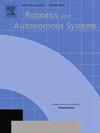基于纯几何规划的移动机器人无碰撞跟踪
IF 4.3
2区 计算机科学
Q1 AUTOMATION & CONTROL SYSTEMS
引用次数: 0
摘要
本文提出了一种针对未知环境中移动机器人的纯几何规划方法,以确保在安全时间间隔内避免与障碍物发生碰撞,同时向目标移动。机器人最初使用二维激光雷达检测障碍物点云。采用欧氏聚类将点云划分为不同的点类。然后将每个点类识别为代表障碍物的定向闭环矩形。设计了一个相对方向 kd 树来存储障碍物的顶点,并确定在避障算法中应考虑哪些障碍物。引入速度分割器以获得可能的避障速度线性凸区域。然后利用线性规划来计算最佳避障速度,以便进行控制。还提出了一种虚拟参考点方法,以解决奇异配置中目标无法达到的问题。实验结果表明,定向闭环矩形和相对方向 kd 树有助于利用低成本传感器设备快速更新所需障碍点。演示了特定场景下的确定性路径,证实了几何规划方法在避障速度区域和最佳避障速度方面的可靠性。提议的算法在有多个障碍物和涉及移动障碍物的动态环境中得到了进一步验证。本文章由计算机程序翻译,如有差异,请以英文原文为准。
Collision-free tracking for a mobile robot based on purely geometric planning
A purely geometric planning method for a mobile robot in unknown environments is proposed to ensure collision avoidance with obstacles within the safety time interval while moving toward the goal. The robot initially detects a point cloud of obstacles using a 2D LiDAR. Euclidean clustering is employed to classify the point cloud into distinct point classes. Each point class is then identified as a directed closed-loop rectangle representing the obstacle. A relative orientation kd-tree is designed to store the vertices of the obstacles and determine which obstacles should be considered in the obstacle avoidance algorithm. A velocity divider is introduced to obtain a linear convex area of possible obstacle avoidance velocities. Linear planning is then used to calculate the optimal obstacle avoidance velocity for control. A virtual reference point method is proposed to address the problem of an unreachable goal in a singular configuration. Experimental results show that the directed closed-loop rectangle and relative orientation kd-tree facilitate rapid updates of required obstacle points with low-cost sensor equipment. A deterministic path for a given scenario is demonstrated, confirming the reliability of the geometric planning method for the obstacle avoidance velocity region and the optimal obstacle avoidance velocity. The proposed algorithm is further validated in scenarios with multiple obstacles and dynamic environments involving moving obstacles.
求助全文
通过发布文献求助,成功后即可免费获取论文全文。
去求助
来源期刊

Robotics and Autonomous Systems
工程技术-机器人学
CiteScore
9.00
自引率
7.00%
发文量
164
审稿时长
4.5 months
期刊介绍:
Robotics and Autonomous Systems will carry articles describing fundamental developments in the field of robotics, with special emphasis on autonomous systems. An important goal of this journal is to extend the state of the art in both symbolic and sensory based robot control and learning in the context of autonomous systems.
Robotics and Autonomous Systems will carry articles on the theoretical, computational and experimental aspects of autonomous systems, or modules of such systems.
 求助内容:
求助内容: 应助结果提醒方式:
应助结果提醒方式:


